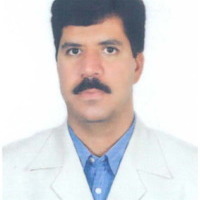Ali Akbar Daya
Sistan and Baluchestan, Mining Engineering, Faculty Member
Research Interests:
Research Interests:
Research Interests:
ABSTRACT
Research Interests:
Chah-Firuzeh Cu deposit is located in the 240km west of Kerman, 135km northwest of Sar-Cheshmeh mine, and 35km northwest of Shar-e-Babak. Eocene volcanic and pyroclastic rocks are main geological units in the area including: andesite,... more
Chah-Firuzeh Cu deposit is located in the 240km west of Kerman, 135km northwest of Sar-Cheshmeh mine, and 35km northwest of Shar-e-Babak. Eocene volcanic and pyroclastic rocks are main geological units in the area including: andesite, dacite, tuff and andesitic tuff. Oligo-Miocene diorite and quartz diorites and Neogene dacite intruded the volcanic. The analysis was carried out on samples from exploratory boreholes show the Cu content is 45159.6 PPm and 41 PPM. First, concentration-volume fractal methods were carried out for Cu and later drown the Concentration-volume chart of this element. The Concentration-volume chart showing two fracture point 0.778% and 0.286% of the grade-scale. The survey was carried out on Cu element in the deposit Characterized three communities full grade, medium grade and low grade for it. Finally drawn three-dimensional map for full grade and low grade communities.
ABSTRACT Delineating the geochemical anomalies from background is a fundamental task in geochemical exploration. Fractal models are practical for the purpose especially concentration-area (C-A) and spectrum-area (S-A) fractal models. The... more
ABSTRACT Delineating the geochemical anomalies from background is a fundamental task in geochemical exploration. Fractal models are practical for the purpose especially concentration-area (C-A) and spectrum-area (S-A) fractal models. The aim of this study is a comparative study of C-A and S-A fractal models for separating regional geochemical anomalies based on 107 stream sediment samples taken from the Shorabhaji region, NW Iran. Results derived via the fractal modeling indicated that the C-A and S-A models are capable of separating anomaly from background. There exists a good correlation between the suggested anomalous area by both of them and the geological particulars in the Shorabhaji area. The advantage of the C-A model is its simplicity and easy computational implementation. The S-A model can decompose better a mixed pattern into a varied geochemical background and anomalies. As a result, the S-A model is a powerful tool for separating of geochemical anomalies from background especially in the complex mixed patterns.
Research Interests:
Research Interests:
Research Interests:
Research Interests:
This paper introduces two methods, one is the element Concentration-perimeter and the other is power spectrum- perimeter method, for separating geochemical anomalies from background based on fractal approach. The variability of the... more
This paper introduces two methods, one is the element Concentration-perimeter and the other is power spectrum- perimeter method, for separating geochemical anomalies from background based on fractal approach. The variability of the element concentration and power spectrum as a function of perimeter from sample sites reveals two different fractal distributional patterns acting within two scale ranges. Therefore, these methods can be used to effectively separate geochemical anomalous areas from background. We compared the anomalous area created using threshold from various methods on the same data, and found that these two methods are superior to the other methods. For validation and demonstration purposes, a case study of Copper element concentration values for 107 stream sediment samples from the western Iran, Kurdistan, Shorab Hajji has been tested.
This paper is devoted to the application of the disjunctive kriging method in the Choghart north anomaly iron ore deposit in Yazd province, Iran. The local distributions of the values of a regionalized attribute at unsampled locations... more
This paper is devoted to the application of the disjunctive kriging method in the Choghart north anomaly iron ore
deposit in Yazd province, Iran. The local distributions of the values of a regionalized attribute at unsampled locations
can be assessed by disjunctive kriging. The case study consists of borehole samples measuring the iron concentration.
A Gaussian isofactorial model is fitted to these data and disjunctive kriging was used to assess the local
probabilities that the actual concentrations exceed a threshold value and to divide the ore into an economic
and uneconomic parts. The tools and concepts are complemented by a set of computer programs and applied
to the case study. The study showed that disjunctive kriging can be applied successfully for modeling the grade
of an ore deposit.
deposit in Yazd province, Iran. The local distributions of the values of a regionalized attribute at unsampled locations
can be assessed by disjunctive kriging. The case study consists of borehole samples measuring the iron concentration.
A Gaussian isofactorial model is fitted to these data and disjunctive kriging was used to assess the local
probabilities that the actual concentrations exceed a threshold value and to divide the ore into an economic
and uneconomic parts. The tools and concepts are complemented by a set of computer programs and applied
to the case study. The study showed that disjunctive kriging can be applied successfully for modeling the grade
of an ore deposit.
